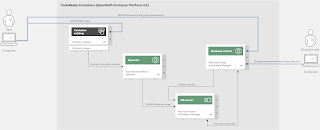Process automation developer tooling
 This article walks through installing the Red Hat Process Automation Manager on OpenShift Container Platform on your local machine using the provided operator. It's leveraging CodeReady Containers and delivers a fully functioning container-native development experience.This means upon logging in, you'll find a project ready to go and it delivers on the promise of a fully functioning developer process automation tooling containerized on your OpenShift Container Platform.
This article walks through installing the Red Hat Process Automation Manager on OpenShift Container Platform on your local machine using the provided operator. It's leveraging CodeReady Containers and delivers a fully functioning container-native development experience.This means upon logging in, you'll find a project ready to go and it delivers on the promise of a fully functioning developer process automation tooling containerized on your OpenShift Container Platform.
Install on CodeReady Containers
There are two options to install and run this project on the OpenShift Container Platform; use your own existing installation or to install on CodeReady Containers which provides you with a local OpenShift cluster.Ensure you have installed OpenShift with CodeReady Containers Easy Install
Datasources, what, why, how?
Hope this post clarifies how a datasource works within a Java EE server and the reasons why you would need a XA Datasource when you have distributed transactions.
The origin of this post is to provide a basic understanding so that the user feels confident when to use or not to use Datasources and XA Datasources.
Where Can We Actually Use DevSecOps?
DevOps is widely adopted as it has shortened the software and application development life cycle by combining IT operations and software development. With DevOps incorporated in many organizations, they are releasing software, features, and updates faster than ever and with greater changes. This means that there are serious challenges in applying and scaling security testing in these processes without drastically slowing down the time taken for such releases.
Hence, security in DevOps has not been embraced as effectively as DevOps itself. Introducing security checks early on in the development process is crucial for effective security. Although many businesses agree that introducing security early in the development life cycle is important, few actually do so. In spite of the risk of missing security threats early on and the headache of rework by adding security to the app development process too late, many businesses continue to incorporate security far too late in the development cycle.

